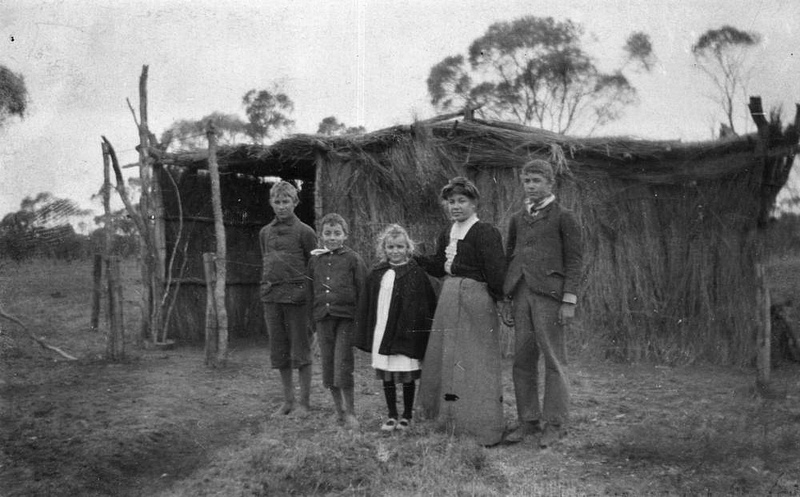Click here for all items related to: Teaching history
Honest History hopes to be useful to teachers of history, particularly at secondary and tertiary levels. We believe history teachers play an important role in helping students to develop the tools to work perceptively and critically with their own national story and to resist the abuse of history. This section reproduces useful material (about writing as well as teaching history) and refers teachers to other sources.

Rayment children and their edifice of knowledge at Isisford, Qld, 1909* (source: Flickr Commons/State Library of Queensland hdl.handle.net/10462/deriv/231471)
Here there are links to resources relevant to the teaching of Australian history (ACARA, AHA, HTAA) and Australian military history (Australian War Memorial, Department of Veterans’ Affairs) and an item about a textbook geared to Australian Curriculum: History. There is a review note on historiography, a link to a historical dictionary, another to a book about maps (with a review), a round-up of notes on seven general histories of Australia, a link to the texts of the very wide-ranging annual Noel Butlin Archives Lectures, a note on big history, abstracts of papers presented at the 2014 conference of the Australian Historical Association, and an article by Raimond Gaita on why study humanities. There are general resources, too: a list of various teaching history items on the site; teaching materials on the medical effects of war; creating multi-modal texts; e-Books; a review note on miscellaneous research sources; a research safari; the Museum Victoria Immigration Museum Portal; HTAA Australian Curriculum History units resources.
Honest History is keenly interested in developments in the history curriculum. Here there is an Honest History Factsheet matching the Year 9 history curriculum to parts of the Honest History website and here there is another Factsheet summarising 2013 remarks about the history curriculum from the Coalition. The Minister speaks here. Here and here are some thoughts from a strong supporter of the current curriculum and here are some thoughts from critics of the current version (Howard, Howard, IPA, here). Later (December 2013 and on) items relating to the history curriculum are Stephens in the Canberra Times, Stephens, Pyne, on the release of the Donnelly-Wiltshire report, Foley & Muldoon (Indigenous history aspects), Taylor, Macintyre, Stephens (with comments), and the Highlights reel on Supplementary material from the report.
Some sources deal with previous contests over the teaching of history (Clark, Clark, Clark, Macintyre, MacMillan) and others address the ethics and techniques of teaching the subject (Arrow, Arrow et al, Bongiorno, Macintyre, featuring Eric Foner and an Honest History team, and by Anna Clark (historical consciousness across generations), Richard J. Evans (Tory interpretations), Margaret MacMillan, Peter Stanley (whether teachers should be patriotic), Peter Stanley on related matters, and Peter Stanley again. Writing history in an interesting way – which, of course, links to teaching it – is the subject of some other sources (Curthoys and McGrath, Curthoys and McGrath) while this reference asks whether history is fiction.
How children are taught about war is a particular interest of Honest History and is addressed by Stephens, Allen interviewing Stephens, here, here, in this review note and in an analysis of the Australian War Memorial’s Roll of Honour Soundscape project. Stephens and Flora analyse the Simpson Prize. Belinda Landsberry’s book Anzac Ted is reviewed by Peter Stanley, and the DVA-War Memorial production, Audacity, is considered comparatively by Stephens. The continously updated material on Teaching children about war is obviously relevant as well.
A few references address the pedagogical aspects of military tourism, including school visits to the Australian War Memorial (Lester and Lake, McKay and Rose), which leads into the role of governments in promoting the teaching of military history (Lake et al, McKenna). Diamadis finds a teaching angle in Gallipoli, and Parkes and Sharp analyse textbooks referring to Gallipoli. Code finds a teaching moment in prime ministerial houses. The National History Challenge essays range widely. Finally, one author looks at how teachers went to war and how they and their students fared then and after (Triolo; see also the subsequent DVA materials) and another reminds us that the internet has fundamentally changed how people learn and how history is disseminated (Brockman).
Note that brief items that were originally Whizzbangs are not covered in this introductory essay but can be found by scrolling through the tagged ‘all items’ list.
17 March 2015
* Description:
Isisford 19 July 1909, To the Undersecretary, D.P.I. [Department of Public Instruction], Herewith please find a photo on P.C. taken by myself. It represents the Rayment family and their bush school in the background. There are one or two more such as this in my district, but this is the most original. These “mites” have almost built this “Edifice of Knowledge” and take a delight in their work. At a future date I shall endeavour to give you an idea of the complete turnout, horses etc, All’s well. your obedient servant, Jas J. Healy. (Information taken from original letter attached to photograph)
Probably the children of William Henry and Maria Rebecca Rayment of Isisford.

